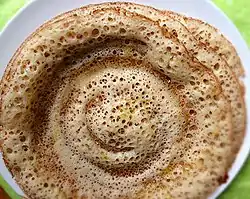Lahoh
Lahoh (Somali: laxoox (𐒐𐒖𐒄𐒝𐒄) or canjeero (𐒋𐒖𐒒𐒃𐒜𐒇𐒙), Arabic: لحوح, romanized: laḥūḥ [laħuːħ]), Hebrew: לַחוּח, romanized: lachoch) is a spongy, flat pancake-like bread.[1] It is a type of flat bread eaten regularly in Somalia, Djibouti, Ethiopia and Yemen. Yemenite Jewish immigrants popularized the dish in Israel.[2] It is called Laxoox/Lahoh or Canjeero/Canjeelo in Somaliland, Somalia and Djibouti, and called Lahoh/Lahuh in Yemen, respectively.
 | |
| Alternative names | Lahooh, Laxoox, Canjeero, and Canjeelo |
|---|---|
| Type | Flatbreads/Pancake |
| Region or state | Horn of Africa and Middle East |
| Main ingredients | Plain flour, Sorghum flour, Wheat flour, Self-rising flour, White cornmeal/cornflour, Water, Yeast, Salt |
| Variations | Cambaabur, Laxoox Abu-Beed |
.jpg.webp) |
| Part of a series on |
| Arab cuisine |
|---|
Preparation
Lahoh is traditionally and typically prepared from a thick batter of sorghum flour (preferred flour for making Laxoox), White cornmeal/cornflour, warm water, yeast, and a pinch of salt. The mixture is beaten by hand until soft and creamy.[3] The batter is then left to ferment overnight to cook and then eat for breakfast. There is a sweet-tasting variety of the dish, one made with eggs,[1] as well as another variety that is spiced and typically eaten in Somali households at breakfast during Eid called Cambaabuur (Ambaabuur).[4] It is traditionally baked on a metallic circular stove called a taawa. Lacking that, it can also be baked in an ordinary pan.
Regional consumption
In Somalia, Djibouti, and in parts of Ethiopia and Kenya, for breakfast (which is where Lahoh is typically eaten), it is consumed with subag (a Somali butter/ghee), olive oil, sesame oil, and sugar or honey or “beer” (liver and onions), “suqaar” (stir-fry meat), or with “odkac/muqmad”. Occasionally it is eaten for lunch, which is when it is eaten with a Somali stew, soup, or curry. It is almost always consumed with Somali tea.[1]
In Yemen, it is often sold on the street by peddlers.[5] It can also be found in Israel, where it was introduced by Yemenite Jews who immigrated there.[6]
References
- Mohamed Diriye Abdullahi, Culture and Customs of Somalis, (Greenwood Press: 2001), p. 113.
- "Yemenite lahoh" in www.deliciousisrael.com
- Preparing Lahoh
- http://xawaash.com/?p=4435#sthash.zygwh2Ob.dpbs
- Dholas and other straw hats come into season Archived 2012-03-08 at archive.today
- Hatikva market — the other side of Tel Aviv Archived 2015-04-27 at the Wayback Machine
